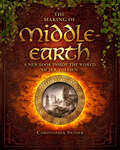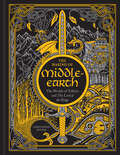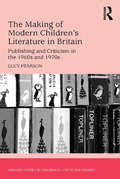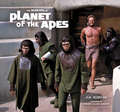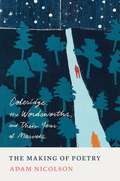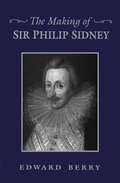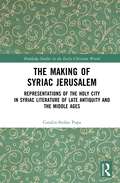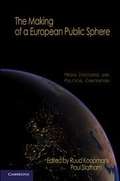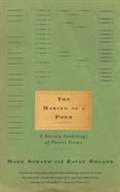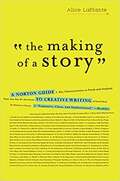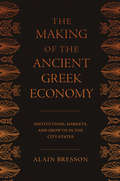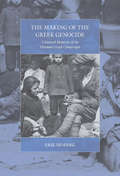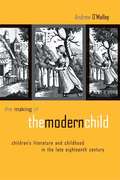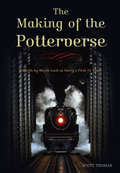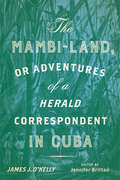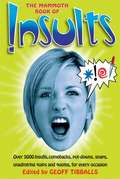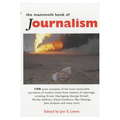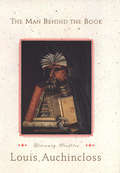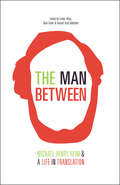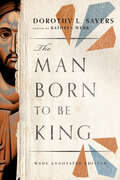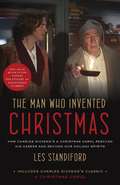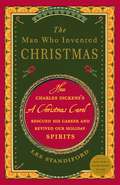- Table View
- List View
The Making of Middle-Earth: A New Look Inside the World of J. R. R. Tolkien
by Christopher A. SnyderThis study “adds an important voice to the growing body of Tolkien scholarship,” covering the author’s life, influences, and original mythology (The Boston Globe).J. R. R. Tolkien’s epic fantasy adventure, The Lord of the Rings, is universally regarded as one of history’s best-loved literary works. Now medieval scholar and Tolkien expert Christopher Snyder presents the most in-depth exploration yet of Tolkien’s source materials for Middle-earth—from the languages, poetry, and mythology of medieval Europe and ancient Greece to the halls of Oxford and the battlefields of World War I. Fueled by the author’s passion for all things Tolkien, this richly illustrated book also reveals the surprisingly pervasive influence of Tolkien’s timeless fantasies on modern culture.
The Making of Middle-earth: The Worlds of Tolkien and The Lord of the Rings
by Christopher A. SnyderThis volume is perhaps the most in-depth exploration ever undertaken of Tolkien's world. Accessible but authoritative, and fully illustrated, it is now being reissued with a stunning new cover treatment and updated commentary on new books, films, games, and shows. This book, originally published in 2013 and richly illustrated with photographs and artwork , was the first to connect all the threads of influence on Tolkien that infused his creation of Middle-earth—from the languages, poetry, and mythology of medieval Europe and ancient Greece and Rome to the halls of Oxford and the battlefields of World War I. Snyder examines the impact of these works on our modern culture, from 1960s counterculture to fantasy publishing, gaming, music, and beyond. The reissue has a gorgeous, updated cover design with a custom illustration on foil-stamped faux cloth and additional pages of material covering new developments.
The Making of Modern Children's Literature in Britain: Publishing and Criticism in the 1960s and 1970s (Studies in Childhood, 1700 to the Present)
by Lucy PearsonLucy Pearson’s lively and engaging book examines British children’s literature during the period widely regarded as a ’second golden age’. Drawing extensively on archival material, Pearson investigates the practical and ideological factors that shaped ideas of ’good’ children’s literature in Britain, with particular attention to children’s book publishing. Pearson begins with a critical overview of the discourse surrounding children’s literature during the 1960s and 1970s, summarizing the main critical debates in the context of the broader social conversation that took place around children and childhood. The contributions of publishing houses, large and small, to changing ideas about children’s literature become apparent as Pearson explores the careers of two enormously influential children’s editors: Kaye Webb of Puffin Books and Aidan Chambers of Topliner Macmillan. Brilliant as an innovator of highly successful marketing strategies, Webb played a key role in defining what were, in her words, ’the best in children’s books’, while Chambers’ work as an editor and critic illustrates the pioneering nature of children's publishing during this period. Pearson shows that social investment was a central factor in the formation of this golden age, and identifies its legacies in the modern publishing industry, both positive and negative.
The Making of Planet of the Apes
by Jonathan RinzlerFOREWORD BY FRASER HESTONIn celebration of the fiftieth anniversary of Planet of the Apes, the classic science-fiction film from 1968, The Making of Planet of the Apes tells the film and offers exclusive, never-before-seen photographs and concept art.Based on Pierre Boulle's novel La Planéte de singes, the original Planet of the Apes was one of the most celebrated films of the 1960s and beyond. Starring Hollywood icons Charlton Heston and Roddy McDowall, the movie struck a chord with the world and sparked a franchise that included eight sequels, two television series, and a long-running comic book. Now, five decades after its theatrical release, New York Times bestselling author J. W. Rinzler tells the thrilling story of this legendary Hollywood production—a film even Boulle thought would be impossible to make.With a foreword by Fraser Heston, Charlton Heston's son, The Making of Planet of the Apes is an entertaining, informative experience that will transport readers back to the strange alternate Earth ruled by apes, and bring to life memorable characters such as Cornelius, Dr. Zira, Dr. Zaius, and Taylor, the human astronaut whose time-traveling sparks an incredible adventure. Meticulously researched and designed to capture the look and atmosphere of the film, The Making of Planet of the Apes is also packed with a wealth of concept paintings, storyboards, and never-before-seen imagery—including rare journal pages and sketches from Charlton Heston's private collection—as well as color and black-and-white unit photography, posters, and more unique ephemera.Comprehensive in scope, The Making of Planet of the Apes is the definitive look at the original blockbuster film, a must-have for fans, film buffs, and collectors alike.
The Making of Poetry: Coleridge, the Wordsworths, and Their Year of Marvels
by Adam NicolsonBrimming with poetry, art, and nature writing—Wordsworth and Coleridge as you've never seen them beforeJune 1797 to September 1798 is the most famous year in English poetry. Out of it came Samuel Taylor Coleridge's The Rime of the Ancient Mariner and “Kubla Khan,” as well as his unmatched hymns to friendship and fatherhood, and William Wordsworth’s revolutionary songs in Lyrical Ballads along with “Tintern Abbey,” Wordsworth's paean to the unity of soul and cosmos, love and understanding.In The Making of Poetry, Adam Nicolson embeds himself in the reality of this unique moment, exploring the idea that these poems came from this particular place and time, and that only by experiencing the physical circumstances of the year, in all weathers and all seasons, at night and at dawn, in sunlit reverie and moonlit walks, can the genesis of the poetry start to be understood.The poetry Wordsworth and Coleridge made was not from settled conclusions but from the adventure on which they embarked, thinking of poetry as a challenge to all received ideas, stripping away the dead matter, looking to shed consciousness and so change the world. What emerges is a portrait of these great figures seen not as literary monuments but as young men, troubled, ambitious, dreaming of a vision of wholeness, knowing they had greatness in them but still in urgent search of the paths toward it.The artist Tom Hammick accompanied Nicolson for much of the year, making woodcuts from the fallen timber in the park at Alfoxden where the Wordsworths lived. Interspersed throughout the book, his images bridge the centuries, depicting lives at the source of our modern sensibility: a psychic landscape of doubt and possibility, full of beauty and thick with desire for a kind of connectedness that seems permanently at hand and yet always out of reach.
The Making of Sir Philip Sidney
by Edward DerryDoes a poet make himself, or do his culture and his fiction make him? Sir Philip Sidney is one of the most popular and enduring of Elizabethan authors, and one of those most preoccupied with the relationship between self, society, and art. Edward Berry's The Making of Sir Philip Sidney explores how Sidney 'made' or created himself as a poet by 'making' representations of himself in the roles of some of his most literary creations: Philisides, Astrophil, and the intrusive persona of the Defence of Poetry. Focusing on the significance of these and other self-representations throughout Sidney's career, Berry combines biography, social history, and literary criticism to achieve a carefully balanced portrayal of the poet's life and work. This is a book that makes a significant contribution to our understanding of Sidney, and is likely to appeal to both students and scholars of Sidney, as well as to those wishing to understand the cultural events that shaped this central figure of the English Renaissance.
The Making of Syriac Jerusalem: Representations of the Holy City in Syriac Literature of Late Antiquity and the Middle Ages (Routledge Studies in the Early Christian World)
by Catalin-Stefan PopaThis book discusses hagiographic, historiographical, hymnological, and theological sources that contributed to the formation of the sacred picture of the physical as well as metaphysical Jerusalem in the literature of two Eastern Christian denominations, East and West Syrians. Popa analyses the question of Syrian beliefs about the Holy City, their interaction with holy places, and how they travelled in the Holy Land. He also explores how they imagined and reflected the theology of this itinerary through literature in Late Antiquity and the Middle Ages, set alongside a well-defined local tradition that was at times at odds with Jerusalem. Even though the image of Jerusalem as a land of sacred spaces is unanimously accepted in the history of Christianity, there were also various competing positions and attitudes. This often promoted the attempt at mitigating and replacing Jerusalem’s sacred centrality to the Christian experience with local sacred heritage, which is also explored in this study. Popa argues that despite this rhetoric of artificial boundaries, the general picture epitomises a fluid and animated intersection of Syriac Christians with the Holy City especially in the medieval era and the subsequent period, through a standardised process of pilgrimage, well-integrated in the custom of advanced Christian life and monastic canon. The Making of Syriac Jerusalem is suitable for students and scholars working on the history, literature, and theology of Syriac Christianity in the late antique and medieval periods.
The Making of a European Public Sphere
by Ruud Koopmans Paul StathamThis book investigates an important source of the European Union's recent legitimacy problems. It shows how European integration is debated in mass media, and how this affects democratic inclusiveness. Advancing integration implies a shift in power between governments, parliaments, and civil society. Behind debates over Europe's "democratic deficit" is a deeper concern: whether democratic politics can perform effectively under conditions of Europeanization and globalization. This study is based on a wealth of unique data from seven European countries, combining newspaper content analyses, an innovative study of Internet communication structures, and hundreds of interviews with leading political and media representatives across Europe. It is by far the most far-reaching and empirically grounded study on the Europeanization of media discourse and political contention to date, and a must-read for anyone interested in how European integration changes democratic politics and why European integration has become increasingly contested.
The Making of a Poem: A Norton Anthology of Poetic Forms
by Mark Strand Eavan BolandThis anthology illuminates the history, practice, and wonder of our most elusive art. Intended for all those who love poetry, the anthology draws the reader into the excitement and entertainment of various poetic forms
The Making of a Story: A Norton Guide to Creative Writing
by Alice LaPlanteThe Making of a Story is a fresh and inspiring guide to the basics of creative writing―both fiction and creative nonfiction. Its hands-on, completely accessible approach walks writers through each stage of the creative process, from the initial triggering idea to the revision of the final manuscript. It is unique in combing the three main aspects of creative writing instruction: process (finding inspiration, getting ideas on the page), craft (specific techniques like characterization), and anthology (learning by reading masters of the form). Succinct, clear definitions of basic terms of fiction are accompanied by examples, including excerpts from masterpieces of short fiction and essays as well as contemporary novels. A special highlight is Alice LaPlante's systematic debunking of many of the so-called rules of creative writing. <p><p> This book is perfect for writers working alone as well as for creative writing classes, both introductory and advanced.
The Making of the Ancient Greek Economy
by Steven Rendall Alain BressonThis comprehensive introduction to the ancient Greek economy revolutionizes our understanding of the subject and its possibilities. Alain Bresson is one of the world's leading authorities in the field, and he is helping to redefine it. Here he combines a thorough knowledge of ancient sources with innovative new approaches grounded in recent economic historiography to provide a detailed picture of the Greek economy between the last century of the Archaic Age and the closing of the Hellenistic period. Focusing on the city-state, which he sees as the most important economic institution in the Greek world, Bresson addresses all of the city-states rather than only Athens. An expanded and updated English edition of an acclaimed work originally published in French, the book offers a groundbreaking new theoretical framework for studying the economy of ancient Greece; presents a masterful survey and analysis of the most important economic institutions, resources, and other factors; and addresses some major historiographical debates. Among the many topics covered are climate, demography, transportation, agricultural production, market institutions, money and credit, taxes, exchange, long-distance trade, and economic growth.The result is an unparalleled demonstration that, unlike just a generation ago, it is possible today to study the ancient Greek economy as an economy and not merely as a secondary aspect of social or political history. This is essential reading for students, historians of antiquity, and economic historians of all periods.
The Making of the Greek Genocide: Contested Memories of the Ottoman Greek Catastrophe (War and Genocide #23)
by Erik SjöbergDuring and after World War I, over one million Ottoman Greeks were expelled from Turkey, a watershed moment in Greek history that resulted in hundreds of thousands of deaths. And while few dispute the expulsion's tragic scope, it remains the subject of fierce controversy, as activists have fought for international recognition of an atrocity they consider comparable to the Armenian genocide. This book provides a much-needed analysis of the Greek genocide as cultural trauma. Neither taking the genocide narrative for granted nor dismissing it outright, Erik Sjöberg instead recounts how it emerged as a meaningful but contested collective memory with both nationalist and cosmopolitan dimensions.
The Making of the Modern Child: Children's Literature in the Late Eighteenth Century (Children's Literature and Culture #Vol. 28)
by Andrew O'MalleyThis book explores how the concept of childhood in the late-18th century was constructed through the ideological work performed by children's literature, as well as pedagogical writing and medical literature of the era. Andrew O'Malley ties the evolution of the idea of "the child" to the growth of the middle class, which used the figure of the child as a symbol in its various calls for social reform.
The Making of the Potterverse: A Month-by-Month Look at Harry's First 10 Years
by Scott ThomasExperience the magic again with this chronicle of the young wizard who took the world by storm! From the moment that J. K. Rowling conceived the idea of Harry Potter during a train ride, until the 1997 UK publication of Harry Potter and the Philosopher&’s Stone, The Making of the Potterverse tells the history of one of today&’s most beloved sagas—in print, on screen, and in real life as waves of Pottermania swept fans young and old. Covering the phenomenon through the theatrical release of Harry Potter and the Order of the Phoenix, this book covers all of the major and minor news events centering on the world of Harry Potter, interweaving quotes from the films&’ cast and crew members—among them Daniel Radcliffe, Emma Watson, and Rupert Grint; directors Chris Columbus (The Sorcerer&’s Stone, The Chamber of Secrets), Alfonso Cuarón (The Prisoner of Azkaban), and Mike Newell (The Goblet of Fire); producer David Heyman, and behind-the-scenes personnel who bring the magic to life.
The Mambi-Land, or Adventures of a Herald Correspondent in Cuba: A Critical Edition (New World Studies)
by James J. O'KellyIn late 1872, the New York Herald named James J. O’Kelly its special correspondent to Cuba, to cover what would later be known as the Ten Years’ War. O’Kelly was tasked with crossing Spanish lines, locating the insurgent camps, and interviewing the president of the Cuban republic, Carlos Manuel de Céspedes. O’Kelly became a political lightning rod when, after fulfilling his mission, he was arrested, court-martialed, and threatened with execution in Spanish Cuba. For the book that followed, The Mambi-Land, or Adventures of a Herald Correspondent in Cuba, O’Kelly assembled edited versions of the eighteen dispatches he sent to the Herald, some written in the remotest imaginable places in the Cuban interior.The Mambi-Land constitutes the first book-length account of Cuba’s Ten Years’ War for independence from Spain (1868–1878) and provides a window on an understudied moment in U.S.-Cuba relations. More than recovering an important lost work, this critical edition draws attention to Cuba’s crucial place in American national consciousness in the post–Civil War period and represents a timely and significant contribution to our understanding of the complicated history of Cuba-U.S. relations.
The Mammoth Book of Insults (Mammoth Books #456)
by Geoff TibballsNever be stuck for a wicked line again! - the ultimate collection of insultsHere is the biggest and best ever collection of insults and sharp retorts for when you just wish you could have thought of something faster. Editor Geoff Tibballs presents more than 5,000 come-backs, put-downs, snaps, insults, unadmiring quips and quotes, for every occasion. From the most elegant of studied insults to the wickedest of putdowns, from the language of the street to the literary, political, and entertainment worlds, from playground insults to sports, family and marriage jibes - here is every possible barb you could ever need, guaranteed to crack up all those around you. As an outsider, what do you think of the human race? Your mother's so fat, she has her own area code. Are your parents siblings? Anyone who told you to be yourself couldn't have given you worse advice. Is there no beginning to your talents? You'd be out of your depth in a puddle. Don't you need a licence to be that ugly? I'd like to see things from your point of view but I can't get my head that far up my arse. I'd love to go out with you but I have to worm my dog.
The Mammoth Book of Journalism
by Jon E. LewisThe newspaper has recorded and influenced modern history like nothing else on earth. From The Washington Post's exposure of Watergate, Tom Wolfe's 1960's social documentary in The Electric Cool-Aid Acid Test to Robert Fisk uncovering the slaugher at Chatila, all the articles included here are reportage from the frontline of life. The 100 dispatches collected here are reports which have caught most vividly the greatest events of the twentieth century, the editorials which have changed our thinking, the criticisms which have penetrated most deeply into contemporary culture. Most of all, they offer a snapshot of these modern times.
The Mammoth Book of Journalism (Mammoth Books #380)
by Jon E. LewisThe newspaper has recorded and influenced modern history like nothing else on earth. From The Washington Post's exposure of Watergate, Tom Wolfe's 1960's social documentary in The Electric Cool-Aid Acid Test to Robert Fisk uncovering the slaugher at Chatila, all the articles included here are reportage from the frontline of life. These are the editorials that have changed our thinking and the criticisms that have penetrated most deeply into contemporary culture. Most of all, they offer a snapshot of these modern times.
The Man Behind the Book: Literary Profiles
by Louis AuchinclossTwenty-three biographical essays on writers admired by the National Medal of Arts–winning author of The Education of Oscar Fairfax.For Louis Auchincloss, life and letters are not two things but one. It therefore comes as no surprise that when he writes about writers, their lives are considered as closely as their works. He takes what today is a refreshingly unpopular position: that the artist and his art cannot be teased apart, that biography of criticism and criticism biography. For Mr. Auchincloss, it all boils down to that maxim of Buffon’s: “the style’s the man,” the man behind the book.The twenty-three writers discussed here are a mixed lot—English, American, and French; novelists, poets, and playwrights; Jacobeans, Victorians, and moderns—yet each has meant a great deal to Mr. Auchincloss as a reader and a writer. Some of them are classics, and familiar Auchincloss subjects: Sarah Orne Jewett, Henry James, Ivy Compton-Burnett. Others, among them Prosper Merimee, Harold Frederic, and Amy Lowell, were famous once but are now obscure. In their cases it is Mr. Auchincloss’s self-described task “to explore the reasons for their fall from grace,” reasons that prove to be unfailingly personal as well as artistic. But as Mr. Auchincloss would rather praise and share than damn and dismiss, it is also his task “to seek the portions of their work that may still merit attention.”Alfred Kazin once noted that Mr. Auchincloss’s essays are marked by “perfect literary grace and wit.” These qualities have never been so evident as in this volume, an informal study of some of the author's favorite books and the fascinating artists behind them.
The Man Between
by Michael Henry Heim Sean Cotter Esther Allen Russell Scott ValentinoWhen Michael Henry Heim--one of the most respected translators of his generation--passed away in the fall of 2012, he left behind an astounding legacy. Over his career, he translated two-dozen works from eight different languages, including books by Milan Kundera, Dubravka Ugresic, Hugo Claus, and Anton Chekov.But Mike, as he was known to his legion of friends, was much more than that. His classes at UCLA on translation inspired a new generation of translators, and his work altering the way translation is viewed in the university will impact the livelihood of translators for decades to come.If that weren't enough, upon his death it was revealed that Heim was the anonymous donor responsible for the PEN Translation Fund--the largest fund in America supporting up-and-coming translators.Hundreds of people in the literary community were impacted by Heim's life and actions, and this book is a small way of honoring this quiet, humble man who, among many other things, is responsible for the title The Unbearable Lightness of Being (and all its variants) entering the English idiom.Comprising a number of different sections--a short autobiography, pieces from authors he worked with, worksheets detailing his teaching and translation techniques--The Man Between opens a window onto the life and teachings of Michael Henry Heim, and, similar to David Bellos's Is That a Fish in Your Ear?, will be of great interest to anyone interested in language, international culture, and the art of translation.
The Man Born to Be King: Wade Annotated Edition
by Dorothy L. SayersFrom December 1941 until October 1942, the BBC broadcast a series of radio dramas written by Dorothy L. Sayers.Noted for their use of colloquial English as part of Sayers's effort to bring the Gospels to life in a new way for listeners, the plays were both controversial and incredibly successful, bolstering the morale of the country during the war. They were subsequently published in 1943, and they stand among Sayers's most beloved works to this day.In this new critical and annotated edition, scholar Kathryn Wehr brings fresh insights to the plays, their background, Sayers's creative process, and the ongoing significance of the life of Christ today. Listen again, or for the first time, to the story of the man who was born to be—and still is—king.
The Man Who Invented Christmas (Movie Tie-In): How Charles Dickens's A Christmas Carol Rescued His Career and Revived Our Holiday Spirits
by Les StandifordAs uplifting as the tale of Scrooge itself, this is the story of how Charles Dickens revived the signal holiday of the Western world. Soon to be a major motion picture. Just before Christmas in 1843, a debt-ridden and dispirited Charles Dickens wrote a small book he hoped would keep his creditors at bay. His publisher turned it down, so Dickens used what little money he had to put out A Christmas Carol himself. He worried it might be the end of his career as a novelist. The book immediately caused a sensation. And it breathed new life into a holiday that had fallen into disfavor, undermined by lingering Puritanism and the cold modernity of the Industrial Revolution. It was a harsh and dreary age, in desperate need of spiritual renewal, ready to embrace a book that ended with blessings for one and all. With warmth, wit, and an infusion of Christmas cheer, Les Standiford whisks us back to Victorian England, its most beloved storyteller, and the birth of the Christmas we know best. The Man Who Invented Christmas is a rich and satisfying read for Scrooges and sentimentalists alike.
The Man Who Invented Christmas: How Charles Dickens's A Christmas Carol Rescued His Career and Revived Our Holiday Spirits
by Les StandifordAs uplifting as the tale of Scrooge itself, this is the story of how one writer and one book revived the signal holiday of the Western world.Just before Christmas in 1843, a debt-ridden and dispirited Charles Dickens wrote a small book he hoped would keep his creditors at bay. His publisher turned it down, so Dickens used what little money he had to put out A Christmas Carol himself. He worried it might be the end of his career as a novelist.The book immediately caused a sensation. And it breathed new life into a holiday that had fallen into disfavor, undermined by lingering Puritanism and the cold modernity of the Industrial Revolution. It was a harsh and dreary age, in desperate need of spiritual renewal, ready to embrace a book that ended with blessings for one and all.With warmth, wit, and an infusion of Christmas cheer, Les Standiford whisks us back to Victorian England, its most beloved storyteller, and the birth of the Christmas we know best. The Man Who Invented Christmas is a rich and satisfying read for Scrooges and sentimentalists alike.From the Hardcover edition.
The Man Who Loved Books Too Much: The True Story of a Thief, a Detective, and a World of Literary Obsession
by Allison Hoover BartlettThis is the story of John Gilkey, a man who repeatedly stole rare books, and the journalist who tells of, and gets caught up in, his exploits.
The Man Who Wrote Pancho Villa: Martin Luis Guzman and the Politics of Life Writing
by Nicholas Cifuentes-GoodbodyMartin Luis Guzman was many things throughout his career in twentieth-century Mexico: a soldier in Pancho Villa's revolutionary army, a journalist-in-exile, one of the most esteemed novelists and scholars of the revolutionary era, and an elder statesman and politician. In The Man Who Wrote Pancho Villa, we see the famous author as he really was: a careful craftsman of his own image and legacy. His five-volume biography of Villa propelled him to the heights of Mexican cultural life, and thus began his true life's work. Nicholas Cifuentes-Goodbody shapes this study of Guzman through the lens of "life writing" and uncovers a tireless effort by Guzman to shape his public image.The Man Who Wrote Pancho Villa places Guzman's work in a biographical context, shedding light on the immediate motivations behind his writing in a given moment and the subsequent ways in which he rewrote or repackaged the material. Despite his efforts to establish a definitive reading of his life and literature, Guzman was unable to control that interpretation as audiences became less tolerant of the glaring omissions in his self-portrait.
